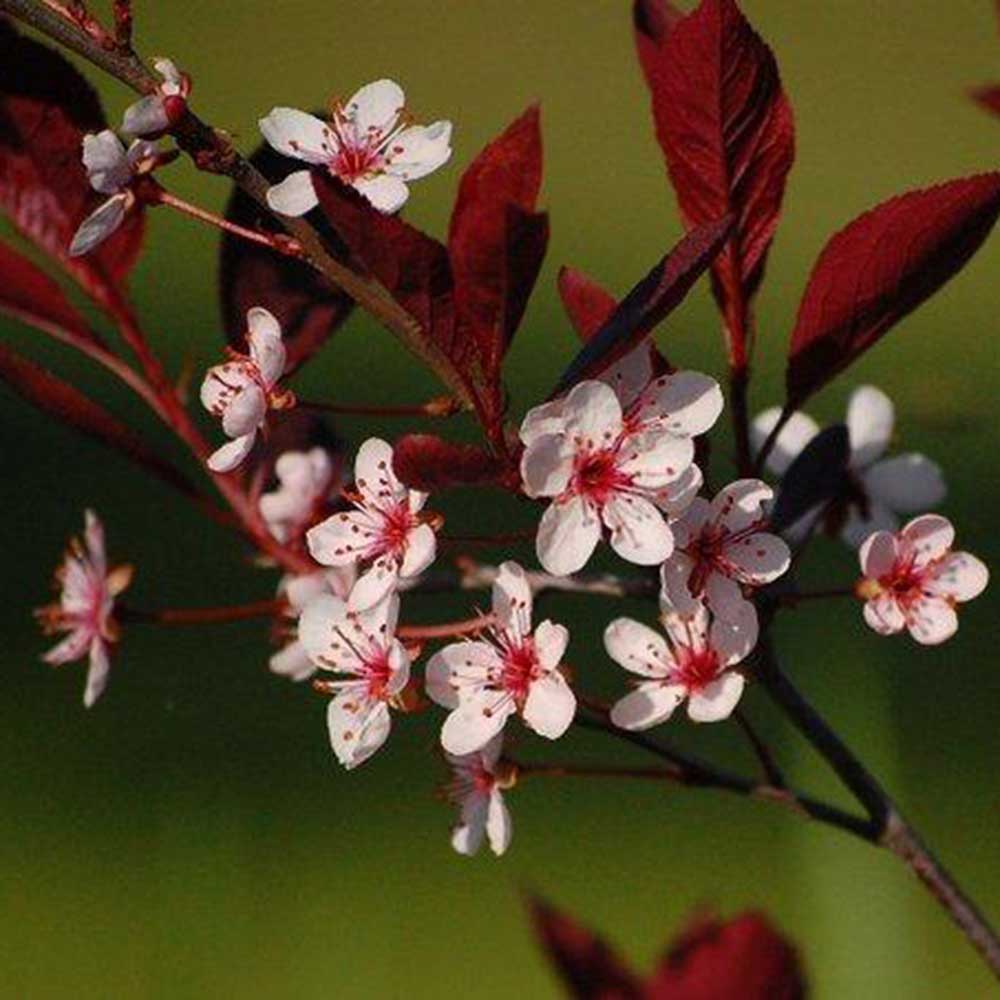Riverdene Garden Center
Purple Leaf Sand Cherry
Purple Leaf Sand Cherry
Couldn't load pickup availability
Prunus × cistena
The Purple Leaf Sand Cherry is a deciduous shrub or small tree prized for its stunning deep purple foliage, fragrant pink-white spring flowers, and hardy adaptability. It is a cold-hardy (Zone 3-7), fast-growing, and ornamental plant that works well as a specimen shrub, hedge, or foundation planting in Southwest Saskatchewan.
Planting & Location
- Hardiness Zone: 3-7 (thrives in prairie climates, excellent cold tolerance)
- Mature Size: 6-10 feet tall, 5-7 feet wide
- Growth Rate: Fast (12-24 inches per year)
- Sunlight Needs: Full sun to partial shade (best foliage color in 6+ hours of sun)
-
Soil Preference:
- Prefers well-drained, loamy soil.
- Tolerates clay, sandy, and slightly alkaline soils.
- Avoid standing water, as it does not tolerate wet feet.
- Spacing: 5-7 feet apart for hedging, 8+ feet apart for individual shrubs.
Watering
- Young Plants (First Year): Water deeply 1-2 times per week to establish roots.
- Established Shrubs: Drought-tolerant but benefits from deep watering every 7-10 days in dry conditions.
- Avoid Overwatering: Prefers moderate soil moisture but does not tolerate soggy conditions.
Fertilizing
- First Year: No fertilizer needed—focus on root establishment.
-
Mature Shrubs:
- Apply a balanced slow-release fertilizer (e.g., 10-10-10) in early spring to encourage healthy growth.
- Organic alternative: Compost or well-rotted manure in spring.
Pruning & Maintenance
- Best Time to Prune: Late winter to early spring, before new growth starts.
-
How to Prune:
- Remove dead, damaged, or weak branches to promote fresh, healthy growth.
- Trim lightly to maintain desired shape and size.
- Every 3-4 years, rejuvenate by cutting back up to one-third of older branches to encourage new growth.
Flowers, Fruit & Foliage
- Bloom Time: Spring (April-May)
- Flower Color: Small, fragrant, pale pink to white blossoms
-
Foliage:
- Spring & Summer: Deep purple to burgundy leaves
- Fall: Reddish-bronze foliage before dropping
- Fruit: Small dark purple cherries (edible but very tart, loved by birds!)
Pest & Disease Management
Resistant to: Drought, urban pollution, and deer (but may need protection from rabbits in winter)
Common Pests:
-
Aphids – May cause curled leaves and sticky honeydew.
- Solution: Spray with insecticidal soap or introduce ladybugs.
-
Japanese Beetles – Can feed on leaves.
- Solution: Hand-pick beetles or use neem oil.
Common Diseases:
-
Black Knot (Fungal Disease) – Forms black, swollen galls on branches.
- Solution: Prune out infected branches 6 inches below galls and dispose of them.
-
Leaf Spot (Fungal or Bacterial) – Causes brown spots on foliage.
- Solution: Improve airflow and avoid overhead watering.
Winter Protection
- Highly winter-hardy—no special protection needed in Zone 3-7.
- Mulching: Apply 2-4 inches of mulch around the base (not touching the trunk) to insulate roots.
- Rodent & Deer Protection: Use tree guards if rabbits or deer are a concern in winter.
Landscape Uses
Great for specimen plantings, hedges, and foundation plantings
Deep purple foliage provides season-long color contrast
Cold-hardy and easy to maintain
Attracts pollinators in spring and birds in summer/fall
Can be shaped into a small tree or kept as a shrub
Additional Notes:
- Purple Leaf Sand Cherry is one of the best ornamental shrubs for adding bold color to landscapes, offering three-season interest with minimal care.
- Lifespan: 15-20 years (prone to declining after this due to disease susceptibility).
- Works well in modern landscapes, cottage gardens, mixed borders, or as a hedge.
Photo courtesy of Foothills Nursery
Share


